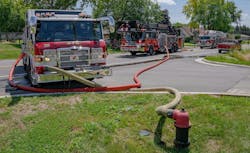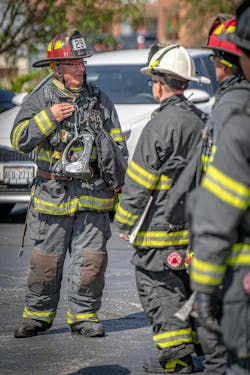Milwaukee Fire Department 150th Anniversary: Shared Services: Moving Forward
For decades, each fire department in Milwaukee County, WI, was on its own. The 14 municipalities that are located in the county wouldn’t respond to a call in a different municipality for numerous reasons.
It wasn’t until 2010 when conversations began on the idea of a borderless approach—more specifically, a shared services agreement. This would allow neighboring fire departments to help one another on calls to maximize efficiency, civilian safety and firefighter safety.
This idea was driven by Milwaukee Fire Department (MFD) Fire Chief Aaron Lipski, Greenfield Fire Department (GFD) Fire Chief (Ret.) Jon Cohn and North Shore Fire/Rescue (NSFR) Fire Chief Robert Whitaker. That said, a borderless approach to fire response isn’t a program that just can be thrown into the mix, particularly within a groundwork of tradition.
An eye-opener
There were times when one department, on a mutual-aid response, drove by another department that was closer to the call. As well, the MFD wouldn’t go into the suburbs for a call and neighboring departments wouldn’t go into Milwaukee.
One day, there was a fire on the east side of Milwaukee. A MABAS (Mutual Aid Box Alarm System) alarm was activated for the first time in 20 years. (MABAS is an organized box alarm dispatch system that’s used in Wisconsin and Illinois.) According to Cohn, there was no coordination or plan.
In the early 2010s, the MFD was transitioning with its chief staff. Along with that, it faced budget cuts and staffing problems. The installation of Fire Chief (Ret.) Mark Rohlfing began conversations about doing mutual aid on larger-scale incidents.
Then-Battalion Chief Lipski sent a letter to all of the county’s chiefs looking to get together to show each other what the gist of each department’s basic operations were. According to Lipski, it was a huge eye-opener. From there, a shared services agreement and an equipment-sharing agreement came into play. This was something that had to be presented to elected officials and pushed through the governing body.
The shared services agreement would allow the borders of each city to be dropped when it comes to responding to a call. If help was needed, a call would be sent by the most appropriate department. The equipment-sharing agreement would allow one department to borrow, if needed, a fire engine, ladder truck and ambulance from another department.
Breaking down barriers
The shared services concept landed more smoothly than the equipment-sharing concept did. Seven municipalities began to participate with the MFD in shared services, with the GFD, NSFR and the Wauwatosa Fire Department being the first adopters. The relationships between the departments began to expand and flourish, but they still faced many roadblocks.
“I knew that my community was safer if we work together, and vice versa,” Whitaker tells Firehouse, but barriers of long-standing tradition and ‘Am I better?’ needed to be broken down.
Inter-department relationships began to be built via meet-and-greets. After that, joint training started. The different departments needed to get used to each other’s equipment, operations and personnel.
“Meet-and-greets were really important, just to get people together and just build relationships, not only on the chief level but on the firefighter level,” Cohn explains. “Then, it was just going to calls and somewhat realizing we do about 95 percent of the stuff similarly. We’re worried about the 5 percent, and we will continue to work on that.”
Monthly Milwaukee County Fire Chiefs Association (MCFCA) meetings help to bridge the disconnect, too, to get ahead of potential issues. Additionally, day-to-day operations leaders at each department meet monthly to keep the communication, gear and tools “on the same wavelength.” The mentality of “I’m only as good as my neighbor” started to spread.
“We always answered the phone when concern would be raised,” Lipski recounts. “We always tried to deal with it in a quiet fashion, so we weren’t popping people’s heads off. We were trying to respect the concept that it is difficult to change.”
At the operations level
The weight of the program shifted to the operations level. Assistant chiefs and deputy chiefs banded together to compromise, come up with a plan, and implement and operationalize everything. It was developing into a concrete approach, but there still was a long road ahead.
“This operations group was tasked with, ‘OK. We have an agreement. Now get us there,’” Cohn explains. “We set the table, and they’re the ones that put in the work to make sure that operationally it was effective.”
Four holdouts
Four Milwaukee County departments remained out of the shared services agreement, because three different insurance companies weren’t on the same page. Furthermore, there was a thought that if a department was a part of the shared services, it had to join the equipment-sharing agreement—although that wasn’t the case.
In 2019, Cohn was appointed as the president of the MCFCA, and he wanted to get the four other departments on board.
There was a lot of doubt and concern in the beginning on every level, according to Cohn, because of the difficulty of change, long-standing tradition, political implications and egos. Standardized responses and procedures needed to be put in place and expectations of the community needed to be met.
“It’s, again, relationships and cooler heads, because if an issue comes up, it most likely isn’t covered in the agreement,” Cohn says “That’s just the way things work out. So, you try to create the best agreement you can, but you can’t fill in every single blank. Even if you have the best agreement, if you don’t have good relationships, the best agreement is not going to take you over the finish line.”
A big hurdle was the potential for a department to consider that it was going on too many calls in a different municipality and not getting its return, per se. There had to be a switch from a focus on call-for-call to one that pointed toward the big picture.
“It’s not just call-for-call,” Whitaker states. “It’s about citizen safety and firefighter safety. ‘I might be giving more help, but when I have that big incident, I’m getting a lot of help.’ There’s a bigger-picture value here, and that’s one of the bigger challenges that we must keep watching. It’s not something that’s a set-it-and-forget-it-type of thing.”
In 2020, the four remaining departments got on both agreements and now fully participate in the shared services concept. The four departments were assigned mentors to help to get them and their personnel up to speed.
“The Milwaukee Fire Department understands and needs its shared services partners more now than at any point in its history,” Lipski says. “We regard them as equals at long last. We hope that they regard us the same.
“It’s a very good feeling to look at the Milwaukee County map and go, ‘Everybody’s on the same page,’” Lipski adds “When they need help, we can give them that help, and it feels good to be able to do that. And from my standpoint, I can essentially double the size of my fire department just by asking.”
About the Author

Ryan Baker
Ryan Baker is a writer and associate editor with prior experiences in online and print production. Ryan is an associate editor for Firehouse with a master's degree in sciences of communication from the University of Wisconsin-Whitewater. He recently completed a year of teaching Intro to Public Speaking at UW-Whitewater, as part of his graduate program. Ryan acquired his bachelor's degree in journalism in 2023 from UW-Whitewater, and operates currently out of Minneapolis, MN. Baker, also writes freelances for the Ultimate Frisbee Association (UFA) in his free time, while also umpiring baseball for various ages across the Twin Cities Metro Area.

